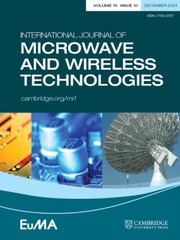No CrossRef data available.
New design of frequency-dependent phase shifter for array sensor applications
Published online by Cambridge University Press: 27 August 2025
Abstract
This article presents a microstrip phase shifter whose frequency-dependent phase response is designed to present the desired phase variation as a useful device for frequency-controlled antenna array systems. The architecture consists of the parallel connection of open-stubs on a main transmission line. The analytical model of the device is presented, its transfer function is derived and compared with a conventional transmission line. The theoretical results show that the phase and amplitude responses can be designed by selecting the number, the length, and the characteristic impedance of the open-stubs. In order to validate the frequency controlled phase shifter model an architecture is proposed, that consists of a three-port device based on a power divider with a phase shifter on one of the output ports and a conventional transmission line on the other. A prototype of this architecture has been manufactured to operate in a frequency range of 2.8 GHz to 3.4 GHz. The magnitude and phase measurements of the scattering parameters show good agreement with the theoretical predictions.
Information
- Type
- Research Paper
- Information
- International Journal of Microwave and Wireless Technologies , Volume 17 , Issue 7 , September 2025 , pp. 1119 - 1124
- Copyright
- © The Author(s), 2025. Published by Cambridge University Press in association with The European Microwave Association.


